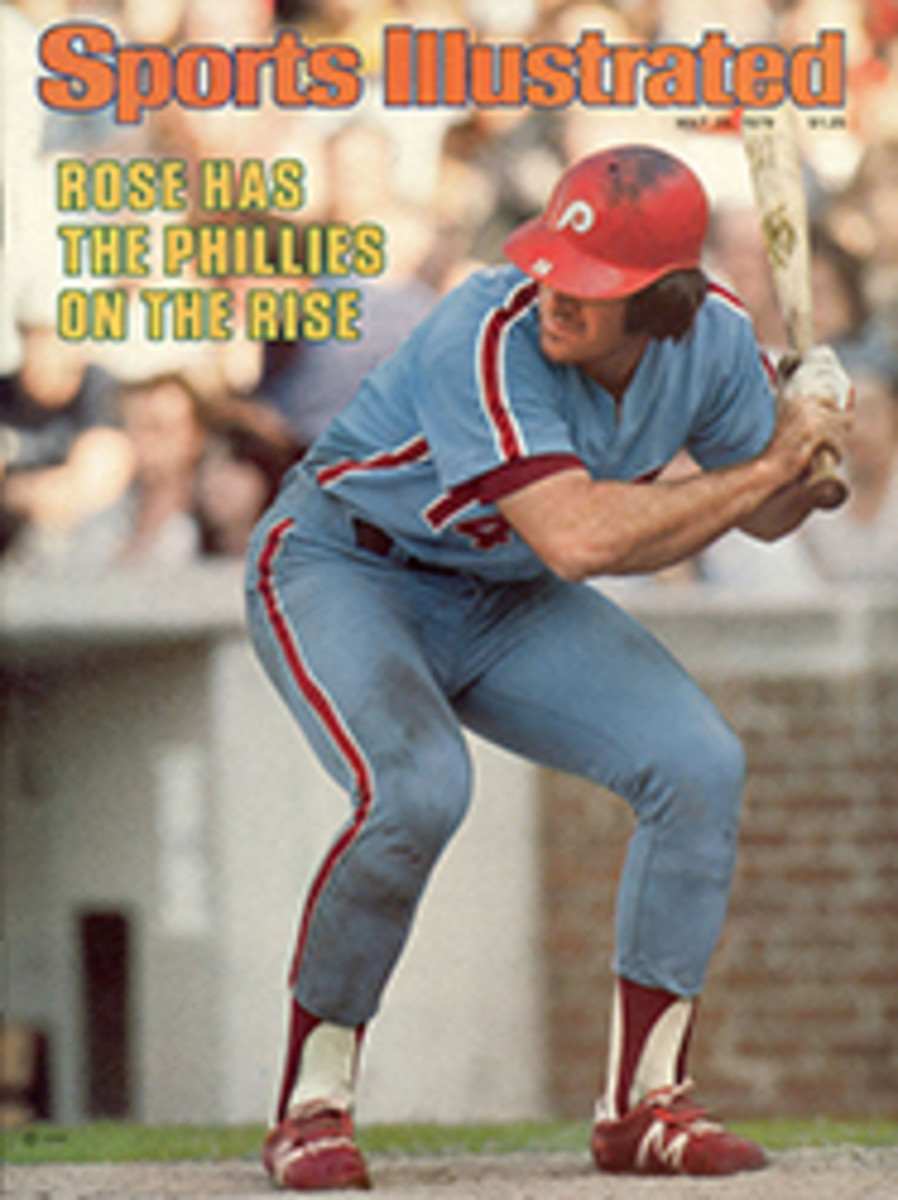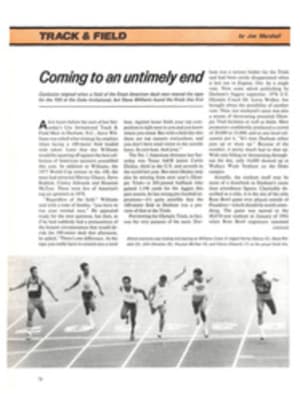
FOR IT'S ONE, TWO, THREE STRIKES YOU'RE OUT AT THE OLD BOARD GAME
"St. Louis, Oct. 7, 1979—Baby Doll Jacobson's two triples and Ken Williams' three RBIs today paced the slugging 1922 St. Louis Browns to a 12-2 romp over the 1975 Boston Red Sox. The win gives the Browns a commanding 3-1 lead in the World Series. Jim Rice's solo homer in the eighth was the only bright spot for Boston, as the Bosox offense continued its Series slump."
This kind of ultimate baseball fantasy is not beyond your reach. You, too, can discover how a lineup of Baby Doll Jacobson, Ken Williams and George Sisler would stack up against Yastrzemski, Fisk and Lynn, et al. To do so, you need neither a computer nor a crystal ball. Just join the aficionados of "All-Star Baseball," a simple board game designed by 75-year-old Ethan Allen, former Yale University baseball coach and outfielder in the 1930s for the Giants and Reds. The major pieces of the venerable game, first issued in 1941, are a cardboard depiction of homely Wrigley Field, ivy walls and all, two metal spinners and cardboard batting discs listing hitting possibilities for each player. ASB cultists, from seven-year-olds to the middle-aged, can be found throughout the country spinning homers, strikeouts and singles. They play the game religiously, collecting batting discs, concocting teams and leagues and recording reams of statistics.
The discs are tailored to individual batting performances and divided into sectors for various kinds of hits and outs. The game casts the pitcher in a role almost as vestigial as the appendix. Pitchers are only valued for their hitting ability. Thus a Bucky Walters or Gene Bearden is desired, but a Sandy Koufax is merely an offensive albatross. Because ASB includes all of baseball's purest hitters, players can devise lineups of unimaginable batting prowess. For all those baseball "never weres," the game offers a kick equivalent to slamming a slow-pitch softball over the leftfielder's head.
I was introduced to All-Star Baseball during my formative years in Brooklyn in the heyday of The Boys of Summer. A major event in my baseball-centered life occurred every time Ethan Allen's publisher answered my letters and mailed me a pack of batting discs of contemporary stars or such alltime All-Stars as Lou Gehrig or Hack Wilson. However, to my disappointment, Ethan Allen never included a Carl Furillo disc among his selections because Furillo didn't give Allen permission.
When my twin sons, Todd and Drew, had matured sufficiently to appreciate the mysteries of ASB, I dusted off the old game board but was saddened to learn some valuable discs were missing, ranging from that of the extraordinary Ty Cobb to the less memorable Sid Gordon. When I sent away for a new Wrigley Field game board and an updated set of discs (if unavailable at retail stores, send a check for $6.10 to CADACO, Inc., 310 W. Polk St., Chicago, Ill. 60607), I also received a subscription form to the ASB News. I sent in the form, and a short time later my first copy of the magazine arrived. What a bonanza! ASB News prints in exhaustive detail individual batting statistics, the results of all kinds of matchups and leagues, as well as the personal confessions of ASB worshipers. One issue gave front-page coverage to the saga of a man over 40, who wrote, "There I was in a cold sweat everytime I played All-Star Baseball, afraid that someone would discover I was playing games. Surreptitiously I would wait until everyone was asleep or out of the house, then I'd quietly slide my game from its hiding place, and to the den I'd sneak. Closing the door, the excitement began. The great names...the calculated spinners...the thrill of imagination...the crack of the bat!
"If the wife, the relatives, the friends found out, they would say, 'What a waste of time.... You've gone nuts.' That's why for five years and some 1,250 games I was a closet player...afraid to come out into the open. Since I discovered ASB News, I've learned there are a lot of nuts like me out there. Some even nuttier. So it's out in the open. I'm proud to have this great hobby. Now I can openly play six games a day, keep statistics, make discs, join mail leagues and participate in tournaments."
Another correspondent told of the formation of a four-man league in the Washington, D.C. area which meets every two weeks, plays six games a night and includes a draft of players from the 1930-32 era. He wrote, "We have had three meetings so far. The first was to get to know each other and discuss the type of league we wanted. The second meeting was the draft. We opened the season two weeks later. I was nervous just driving over there." One durable reader replayed the entire 616-game 1947 National League schedule, with the New York Giants, rather than the Brooklyn Dodgers, winning the pennant.
For those who aspire to outdo Ethan Allen's inventiveness, the magazine serves as a forum for proposals on pitching, fielding and even wind-velocity factors that can be introduced into ASB. There are traditionalists, too. One man told ASB News, "I have been playing ASB since 1950 and have not changed any of the rules that applied then."
Perhaps the most valuable service performed by ASB News is its devotion to the interests of the batting-disc collector. Because I was looking to restore my lost discs and add a few which had eluded me, I found the trading-post section a gold mine—a chance to regain a Ty Cobb or a Sid Gordon. What could match the satisfaction of finally landing a Chick Hafey or restoring Roger Maris to one's collection?
As with some contemporary magazines, the highlight of ASB News is its centerfold. It consists of hard-paper sheets of 24 batting discs, compiled by the editors, of the most obscure and contemporary big-leaguers. In one issue, ASB News surprised its readers with discs of minor league batting wizards Ox Eckhardt (Pacific Coast League) and Rocky Nelson (International League). I wonder whether Ethan Allen's lofty standards were offended. The magazine also offers for sale discs as exotic as those of Al (Two Gun) Gettel, Bud Podbielan, Toby Atwell, the 1922 St. Louis Browns (second-place finishers to the Yankees) and, yes, even a set of Japanese stars.
ASB fans are not only ardent, they often are also persons of broader interests. Take the Los Angeles reader who answered my ad for a batting-disc trade by telephoning me in New Jersey. "Hello, this is J.W. calling from Los Angeles to answer your ad in ASB News."
"You're calling all the way from Los Angeles just to answer my ad?" I asked incredulously.
"Yes," he said, "I really have a thing for discs of 1950s Giants, and I was wondering whether you had any you could trade."
I did have original prints of Henry Thompson and Larry Jansen discs, but since it's unthinkable for a dedicated ASB collector to part with his only disc of any player (even if the 1950s Giants were anathema to him), I told him we had no deal.
Undaunted, J.W. unburdened himself about his most burning quest. "Look," he said with considerable passion, "what I've really been searching for over the past 20 years is a Red Barber Baseball Game." That was a dice game, produced about 30 years ago while Red Barber resided in the catbird seat as sportscaster for the Brooklyn Dodgers.
"Well, matter of fact," I said, feeling like the Good Samaritan, "I recently retrieved an old Red Barber Baseball Game board from my parents' garage sale and would be glad to sell it to you. However, the board split and had to be taped together, and all the players and the ball are lost."
"I don't care about that," J.W. said with some agitation. "All I want is the game board, taped or not. I can't wait till you send it to me so I can begin playing with it," he pleaded. "I'll pay you anything."
My empathy, developed from years of ASB play, prevented me from gouging him for more than $5. (My children, to whom I had promised the proceeds of the sale, wanted me to sell it for much more.) But I made the mistake of mailing the game board third-class, and when it had not arrived after 10 days, J.W. anxiously called me again from Los Angeles. Two more transcontinental telephone calls and 40 days later he wrote me a letter advising me how upset the delay had made him, and how despairing he was of ever owning a Red Barber Baseball Game board. He insisted that I put postal tracers out for the wayward board. Another month passed, and J.W. called again, this time to report that the game board had arrived safely in Los Angeles. The result was a quest's fulfillment on the West Coast, and a Good Samaritan's relief on the East Coast.
With more than 500 ASB discs in my collection, one might think I would be satisfied. But there are always more to be acquired. My Wally Westlake, Preacher Roe and Jerry Coleman discs have disappeared over the years, and I'd dearly like them back in my deck. Can anyone out there help me?
ILLUSTRATION

